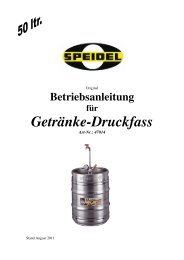Operating and brewing instructions 50l april 2008 - Speidel Tank
Operating and brewing instructions 50l april 2008 - Speidel Tank
Operating and brewing instructions 50l april 2008 - Speidel Tank
Create successful ePaper yourself
Turn your PDF publications into a flip-book with our unique Google optimized e-Paper software.
<strong>Speidel</strong>’s Master Brewer<br />
doing so, that the vaporized water is also replaced. Conversely, the liquid’s level will<br />
fall when the content of basic wort is too low (by the water vaporizing), which leads to<br />
a higher concentration of sugar <strong>and</strong> thus to a higher alcoholic content too. The <strong>brewing</strong><br />
boiler must be open when the boiling phase is carried out. This prevents the wort from<br />
overboiling on the one h<strong>and</strong> <strong>and</strong> it is primarily essential for boiling the hops, so that<br />
unwanted aromatic substances - which would spoil the beer’s taste - can evaporate.<br />
Adding hops to the beer originally served to improve the beer’s shelf life <strong>and</strong><br />
conservation. Add the first hops to the boiling wort between 10 to 15 minutes after the<br />
boiling begins, according to the kind of hops <strong>and</strong> content of bitter substances. The<br />
hops remain in the wort until the boiling time has ended because its substances only<br />
take effect after a longer boiling time <strong>and</strong> they give the intended bitterness of hops to<br />
the beer. Resins <strong>and</strong> oils in the hops will also be released while doing so, which<br />
subsequently give full-bodiedness to the wort together with the malt aroma. Hops can<br />
then be added again approximately 10 minutes before the boiling ends: which only<br />
contributes to the aromatization. It is not possible to separate the bitter substances any<br />
longer during the remaining time. The quantity of hops differs according to the recipe<br />
<strong>and</strong> type of beer. Furthermore, it is dependent on the hops too, which can vary<br />
according to the place where <strong>and</strong> in which year they are cultivated. The hops can be<br />
added in the form of pellets or dried hops. The content of bitter substances is given in<br />
bitter units (BE) <strong>and</strong> it is between 10 to 20 BEs for wheat beer <strong>and</strong> between 25 to 45<br />
BEs for Pilsener beer. Information about the content of bitter substances to the hops is<br />
given as a percentage of alpha acids, which can be between 2% to 4% (approximately<br />
8% for pellets). The quantity of hops can be calculated with the following formula:<br />
Quantity of hops in grams = bitter units (BE) x litres of beer x 10<br />
% of alpha acids x % of bitter substances utilized<br />
It can be assumed that 30% of the bitter substances will be used during a total boiling<br />
duration of between 80 to 90 minutes.<br />
Example:<br />
It is intended to brew 50 litres of wheat beer with a content of bitter substances of 15<br />
BE. The available hops have a 3% content of alpha acids. The following amount of<br />
hops thus results, which will be added when the boiling process begins. The hops<br />
which are added shortly before the boiling ends, are not allowed for in this calculation<br />
because no appreciable quantities of bitter substances will be added to the wort any<br />
more during the brief time.<br />
Grams of hops = 15BE x 50 litres x 10 = 83g<br />
3% x 30%<br />
End of cooking<br />
quit<br />
On completion of the boiling time, a signal tone sounds again,<br />
indicating the end of the <strong>brewing</strong> process. This is<br />
acknowledged by pressing ENTER, <strong>and</strong> the heating is then<br />
switched off.<br />
Page 11 of 26
















